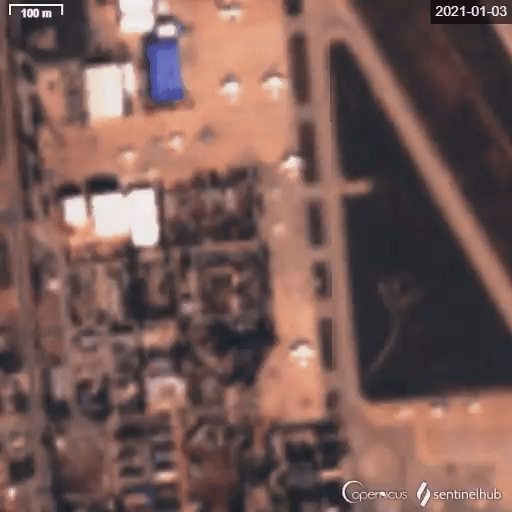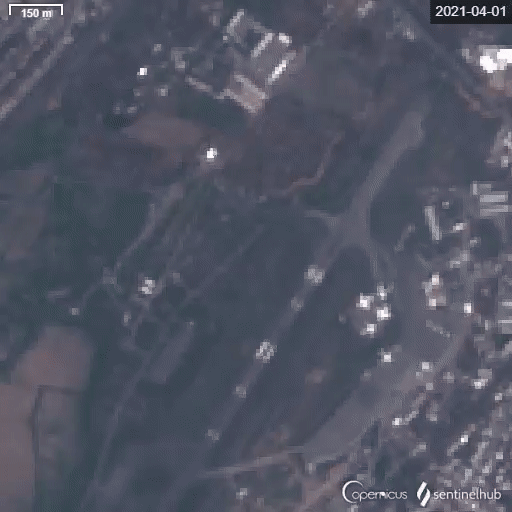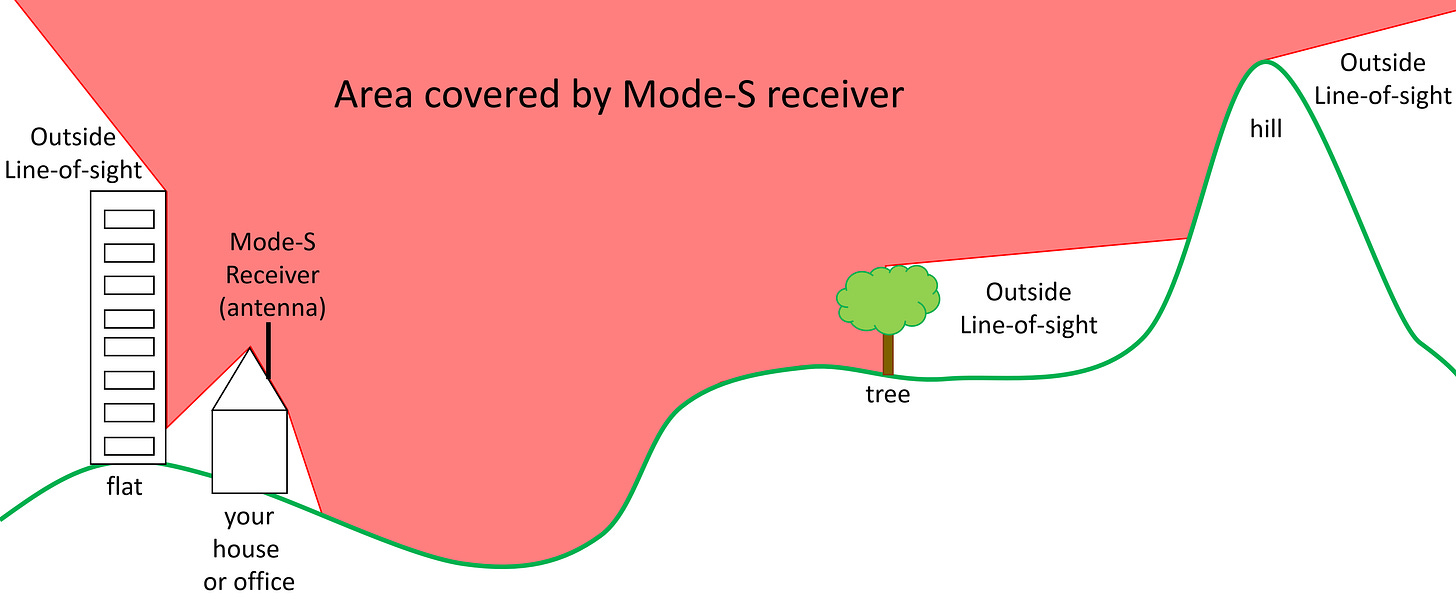The UAE-Ethiopia Airlift: The investigation techniques.
Using Mode-S data, images and satellite images to identify flights to Harar Meda Airport and Addis Ababa Bole International Airport, Ethiopia.
On 07 Oct 2021, I reported identification a total of 45 flights from the United Arab Emirates to Ethiopia. This article is part two of a series of two articles about this find. The first[1] article, which was published yesterday, is about the shady history of the aircraft and their current operator. This second article goes deeper into the technical side: how do I know that these aircraft actually visited Ethiopia?




The technology
Nowadays, most aircraft are equipped with a Mode-S transponder. This article will not go into their exact technical details, but what it comes down to is the following. Aircraft continuously transmit signals, such as their altitude, heading and identity (callsign and Mode-S code), using a standard called Mode-S. These signals are designed to be received by air traffic control and nearby aircraft in order to improve safety.
However, these signals can also be received and decoded by receivers operated by volunteers or enthusiasts on ground. These receivers can “see” aircraft up to over 400 km away in optimal conditions. Received signals are within line of sight: whenever an aircraft is within visual range (so not obstructed by nearby buildings, trees, or the horizon), their signals can be received. Enthusiasts forward this data to websites like ADSBexchange and Flightradar24. These tracking websites receive data from thousands of volunteers and combine this data and put it on the map.
Schematic look at data received by a Mode-S receiver on ground.
Most civil aircraft equipped with a Mode-S transponder use ADS-B, which means that along with the aforementioned other data, they also transmit their location. This means that a single receiver is enough to put the aircraft on the map. Not all aircraft transmit their position. Examples of aircraft that do not transmit their position include most military aircraft, most Ilyushin Il-76 cargo aircraft, including the entire “Fly Sky Airlines” fleet, but also some KLM Cityhopper aircraft. Tracking websites are sometimes still able to put these aircraft on the map: when one and the same signal is received by at least 4 ground receivers, aircraft position can be approximated by a mathematical calculation called MLAT (multilateration).
In countries like the Netherlands, where I am based, data source makes little difference: since there are thousands of volunteers around, almost all aircraft can be drawn on the map regardless of whether their position is known through ADS-B or MLAT.
In other countries, including Ethiopia and most of Africa, very few people send Mode-S data to tracking websites. As a result, only aircraft on full ADS-B can be put on the map, aircraft on MLAT cannot.
However, knowing that a ground receiver can only “see” within line of sight, we know that any aircraft for which we receive signals, has to be within visual range of the receiver. Depending on the position of the receiver, only a particular airport may be within sight, and flights to other destinations will disappear in-flight (when the aircraft are no longer within visual range: disappeared behind the horizon, or behind other obstructions in the vicinity of the receivers).
In the example below, a receiver is able to receive signals of aircraft on ground at Addis Ababa Bole International Airport, but not at Harar Meda Airport, Ethiopia’s main military air base, located about 37 km further southwest.
In this way, positionless Mode-S data that would normally not be visible on aircraft tracking websites like Flightradar24 can still be used to estimate origins and destinations of aircraft. For privacy and security reasons, I cannot provide further details about how I got access to this Mode-S data.



The analysis
Mode-S data
Analysis of positionless Mode-S data shows that Ilyushin Il-76 cargo aircraft from the UAE (where they can generally appear on tracking websites around take-off and landing, since there are enough receivers around) land outside Mode-S coverage in central Ethiopia, so not at Addis Ababa Bole Airport, on over 40 occasions. This data was filtered to only include inbound flights, so a return flight is only counted once.
One question remains: How do I know the destination of aircraft that are not tracked to ground? This is where imagery comes in.
Satellite imagery



Satellite imagery can be used and has been used to visually confirm the location of aircraft, both on ground and in-flight[2]. For identification of aircraft on ground, several conditions need to be met: an earth observation satellite needs to overpass while the aircraft is on ground during daytime and weather conditions should be clear enough to see the ground. Within my research, I typically use Sentinel-2 data. Although the pixel size of 10 meters is not ideal, pros of using Sentinel-2 include free and unlimited access. This also means that my claims can be verified by anybody, for example using the EO Browser[3].
In recent years, I have grown very familiar with the way this Soviet-built cargo aircraft appear on Sentinel-2 satellite imagery. For example, I have used Sentinel-2 to identify Il-76 cargo aircraft in Libya[4], Russia[5], Somalia[6], Armenia[7], Afghanistan[8], the Central African Republic[9], Egypt[10] and Kyrgyzstan[11]. Besides clues like size (length and width), the Ilyushin Il-76 has a typical silhouette with a large wing area and wings placed rather far forwards on the fuselage. This experience allows me to distinguish them from most other aircraft.
In this way, Ilyushins Il-76 have been identified at Harar Meda Military Airport in Ethiopia on multiple occasions, for example on 01 Aug 2021[12], 31 Aug 2021[13], 10 Sep 2021[14] and 20 Sep 2021[15], and these finds match up with available Mode-S logs.



Ground imagery
Besides Mode-S data and satellite imagery, geolocated images of aircraft provide a third source of information. On 04 Sep 2021 for example, “Fly Sky Airlines” Ilyushins Il-76 reg. EX-76003 and UR-FSC were spotted approaching Addis Ababa Bole International Airport, Ethiopia.



Other geolocated images from ground include:
1. Antonov Airlines Antonov An-124 reg. UR-82029 from Chengdu, China, spotted approaching Addis Ababa Bole International Airport after landing at Harar Meda Military Airport on 17 Sep 2021[16];
2. Qeshm Fars Air Boeing 747-200 reg. EP-FAB from Tehran, Iran, spotted at Addis Ababa Bole International Airport on 17 Aug 2021[17];
3. Maximus Air Cargo Antonov An-124 reg. UR-ZYD from Abu Dhabi, UAE, spotted at Addis Ababa Bole International Airport on 18 Apr 2021[18].
How you can help
As has hopefully become clear in this article, having more Mode-S receivers in Ethiopia (or, frankly, anywhere in Africa) would be very beneficial. It would mean we can finally put these flights on the map, so we no longer need to rely on interpretations of positionless Mode-S data, which is unavailable to most end users.
Fortunately, websites like Flightradar24[19], ADSBexchange[20] and Flightaware[21] offer free receivers, oftentimes prioritizing receivers in low-density feeder areas like Africa[22]. For hosting a Mode-S receiver, only an internet connection is required. Plenty documentation and tutorials are available online, showing you how to set everything up.
Besides Mode-S receivers, I am always interested to see images of aircraft taken in or over Ethiopia. My Twitter DMs are open – feel free to send me a message!
Corrigendum
One of the flights listed in the overview of flights was by aircraft hex code 6010EA on 20 Aug 2021. This flight was mistakenly listed as one of the flights to Ethiopia. In reality, this flight went to N’Djamena in Chad.


[3] https://apps.sentinel-hub.com/eo-browser/












































[19] https://www.flightradar24.com/apply-for-receiver
[21] https://flightaware.com/adsb/flightfeeder/
[22] https://www.flightradar24.com/blog/making-the-flightradar24-network-even-stronger/





Are you also tracing private jets? You will be paid more.
How much are those Terrorist tugs promised to pay you? Loser.